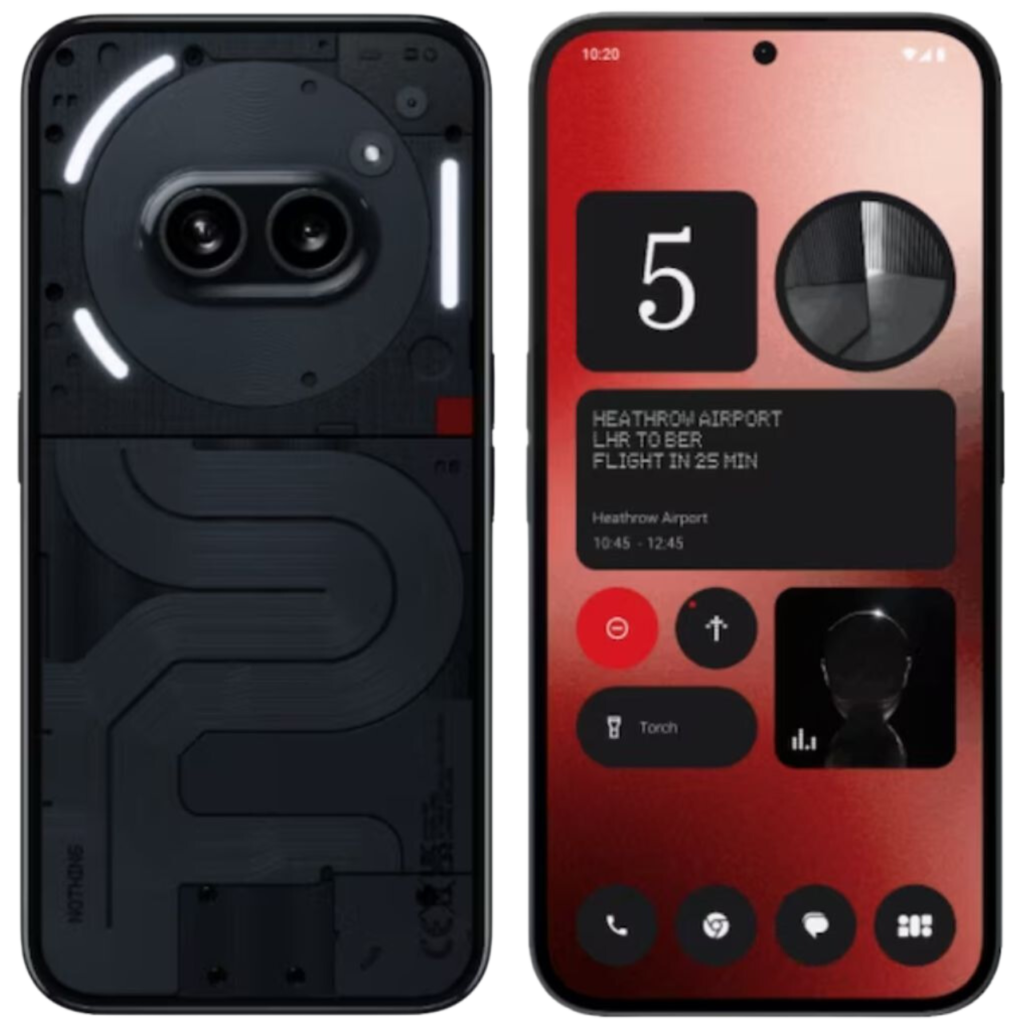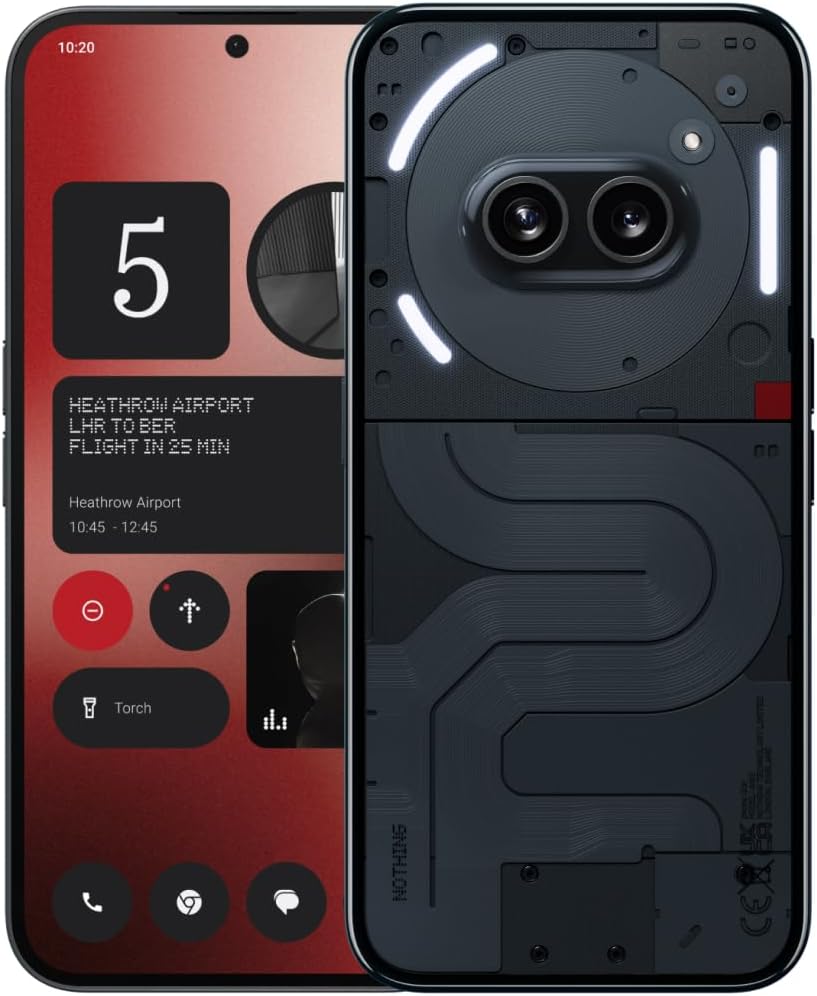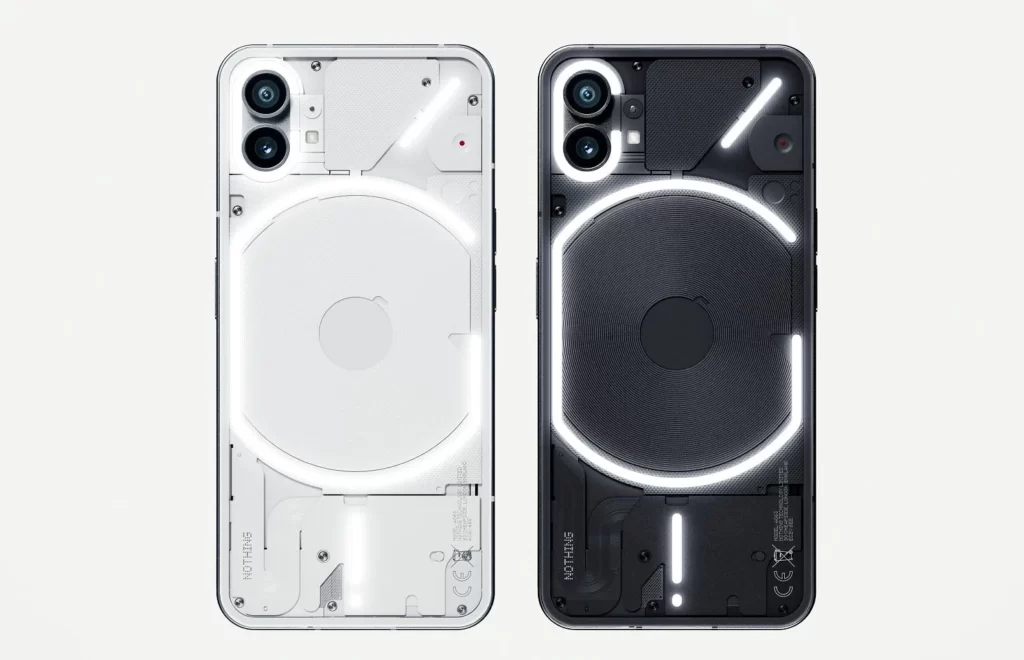Nothing announced its latest addition, the Nothing Phone (2a), eyes immediately turned to its high-end predecessor, the Nothing Phone (2). With a price difference of over £200 between the two, one would expect major gaps in terms of specs and performance. But the reality is perhaps more surprising than expected. Here’s an overview of the main differences between the two devices:
Nothing Phone (2a) and Nothing Phone (2): What are the differences in terms of Glyph interface?
The Nothing Phone (2) continues the design of its predecessor, the Phone (1), by integrating an impressive array of LEDs into the transparent back of the phone. These LEDs can be programmed to display custom patterns based on notifications and calls. Additionally, they can perform convenient actions, such as displaying a timer or even battery life when charging. This feature provides a unique and interactive experience to users.
The Nothing Phone (2a) retains the series’ characteristic transparent back, but with a more discreet implementation of the Glyph interface. Instead of the 11 LEDs found on the Nothing Phone (2), the Nothing Phone (2a) features just three LEDs around the central camera module on the back. While these LEDs can still provide indications for calls, texts, and be used as a timer, they offer a less flashy and less customizable experience than those of its high-end predecessor.

The most notable difference between the Nothing Phone (2a) and the Nothing Phone (2) is the implementation of the Glyph interface. While the Nothing Phone (2) offers a richer, more customizable experience with its 11 LEDs and their advanced features, the Nothing Phone (2a) takes a more modest approach with just three LEDs.
How does the Nothing Phone (2a) screen compare to the Nothing Phone (2)?
Both phones feature a 6.7-inch 120Hz AMOLED display, a significant improvement over the Nothing Phone (1). However, the Nothing Phone (2a) features thinner bezels, measuring just 0.2mm thick for a total thickness of 2.1mm. Additionally, it offers a higher brightness of 700 nits in general use and up to 1100 nits in HBM mode, compared to the 500 nits and 1000 nits respectively of the Nothing Phone (2).

It should also be noted that the Nothing Phone (2) benefits from LTPO technology which allows it to adjust its refresh rate up to 1 Hz to save battery. The Nothing Phone (2a) offers a slightly lower maximum brightness, reaching 1300 nits compared to 1600 nits for the Nothing Phone (2).
Nothing Phone (2a) vs Nothing Phone (2) performance
The Nothing Phone (2) is equipped with the Snapdragon 8+ Gen 1 5G chipset, a high-end chip that delivers exceptional performance. With its Octa-core architecture including a powerful Cortex-X2 clocked at 3.0 GHz, three Cortex-A710s at 2.5 GHz and four Cortex-A510s at 1.8 GHz, the Nothing Phone (2) is ready to take on the challenges challenges of the most demanding tasks.
On the other hand, the Nothing Phone (2a) is powered by the Dimensity 7200 Pro SoC, a solid option in the budget smartphone category. Although its Octa-core CPU is slightly lower in frequency and composition compared to the Snapdragon 8+ Gen 1 5G, with two Cortex-A715 at 2.8 GHz and six Cortex-A510 at 2.0 GHz, it offers still performs satisfactorily for most everyday tasks.

In terms of raw performance, the Snapdragon 8+ Gen 1 5G chipset in the Nothing Phone (2) is undoubtedly more powerful than the Mediatek Dimensity 7200 Pro in the Nothing Phone (2a). However, for most users, the Nothing Phone (2a)’s performance will be more than sufficient to meet their daily needs, such as web browsing, social media, video watching, and even light gaming. For those who need extreme performance for resource-intensive tasks, the Nothing Phone (2) might be the best option.
When it comes to memory, both phones have options that range from 8GB RAM and 128GB storage to 12GB RAM and 256GB storage (There is a 512GB storage variant for the Phone ( 2)). The Phone (2a) was launched with Android 14 operating system with an in-house Nothing OS 2.5 layer. The Phone (2) model was launched with Nothing OS 2.0, but is currently eligible for the Android 14 update.
Camera Comparison: Nothing Phone (2a) vs Nothing Phone (2)
Both phones feature a 50MP main camera, with a fast f/1.88 aperture for sharp results even in low-light conditions. Additionally, they both benefit from optical image stabilization (OIS) for stable and sharp images, even in motion. Matching 50 MP ultra-wide lenses provide a generous 114-degree field of view, allowing you to capture stunning landscapes and spacious scenes with ease.

In the selfie department, both phones are neck and neck. They both feature a 32MP selfie camera, ensuring sharp and detailed self-portraits.
A minor difference is in image processing, where the Nothing Phone (2a) is powered by the 14-bit Imagiq 765, while the Nothing Phone (2) uses the 18-bit Spectra. While this could potentially result in slightly better performance for the Nothing Phone (2), in practice the differences should be minimal.
Battery life and fast charging:
A pleasant surprise for potential users of the Nothing Phone (2a) is its larger battery compared to the Nothing Phone (2). Boasting a capacity of 5,000 mAh, the Nothing Phone (2a) has a subtle advantage over the Nothing Phone (2) with its 4,700 mAh battery. While the difference isn’t massive, it can potentially translate to slightly improved battery life on the Nothing Phone (2a), especially when combined with software and hardware optimizations.
Both devices benefit from an impressive 45W fast charging, which allows for relatively short charging times. The Nothing Phone (2) typically goes from zero to one hundred in just 56 minutes, which is an impressive performance. With its slightly larger battery, the Nothing Phone (2a) might take a little longer to reach full charge, but it should still deliver competitive charging times thanks to its fast charging technology.
Related :
